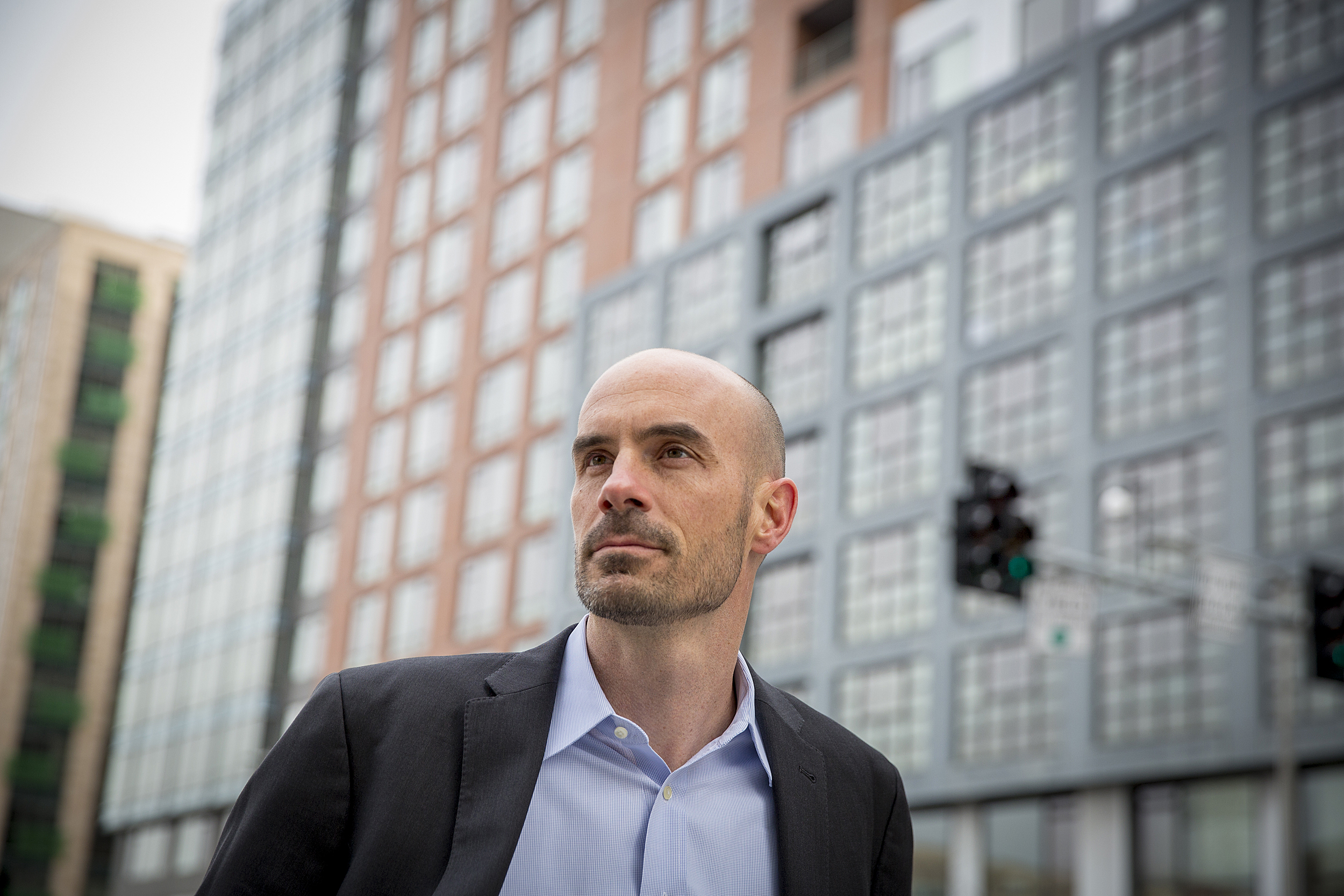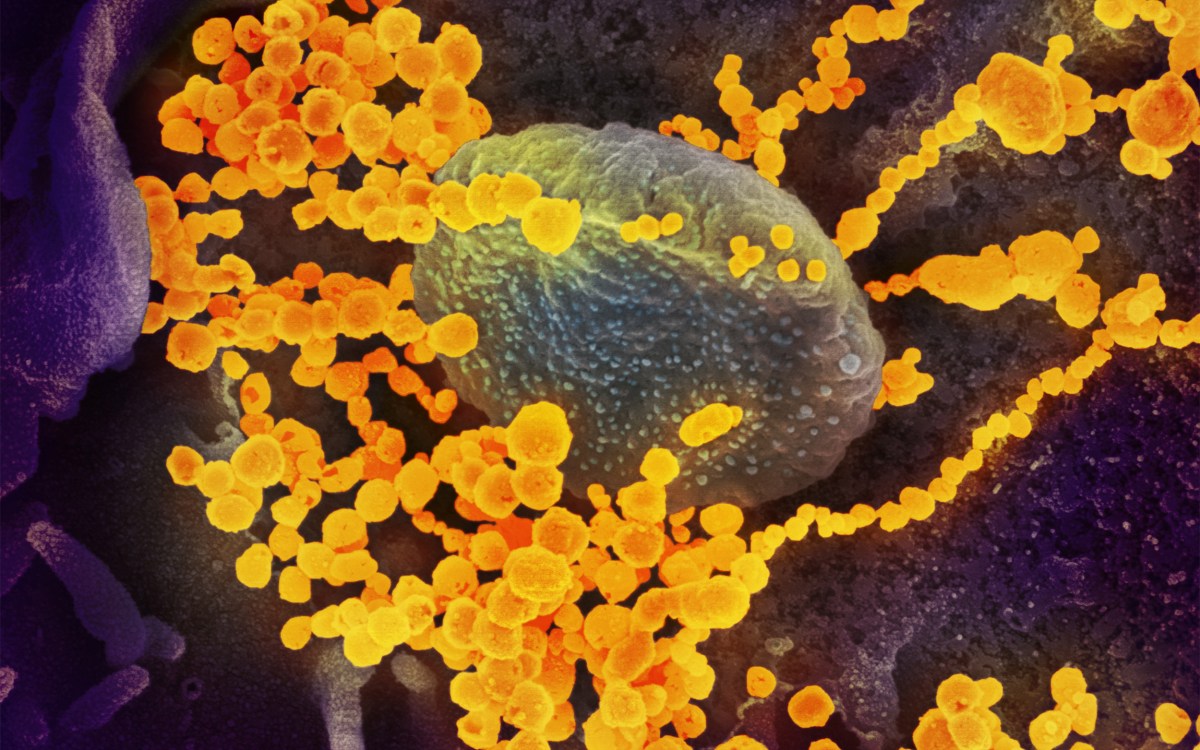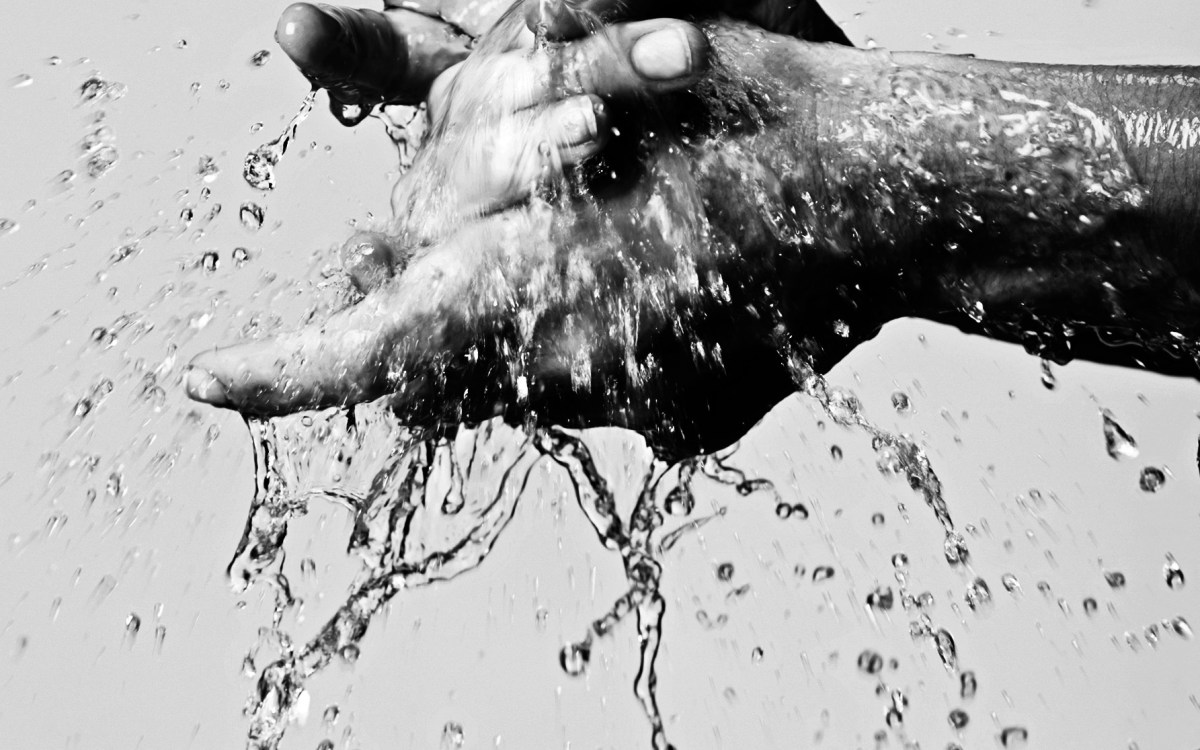
Rose Lincoln/Harvard file photo
How masks and buildings can be barriers to the coronavirus
Healthy buildings expert Joe Allen from the Chan School of Public Health weighs in on ways to help protect yourself from coronavirus
This is part of our Coronavirus Update series in which Harvard specialists in epidemiology, infectious disease, economics, politics, and other disciplines offer insights into what the latest developments in the COVID-19 outbreak may bring.
Joe Allen, assistant professor of exposure assessment science at the Harvard T.H. Chan School of Public Health and director of its Healthy Buildings program, suspects that broader airborne transmission of the coronavirus is likely, and thinks certain precautions indoors and out can help reduce its spread. Allen spoke with the Gazette about ways to stay safe during the pandemic.
Q&A
Joe Allen
GAZETTE: The Centers for Disease Control and Prevention has just recommended individuals wear cloth face coverings in public settings where social distancing is difficult. What do you think?
ALLEN: I had a piece in The Washington Post last week that makes the case that everyone should be wearing masks. It outlines four lines of public health benefits. First, a mask can catch large droplets. So if I cough or sneeze, these large particles get captured by the mask, which means I’m not affecting others. Second, if you and I were out, and even though we’re six feet apart but you are infectious and coughing, the homemade mask acts as a physical barrier for me. [Studies show that some droplets can carry up to 20 feet.] Homemade masks don’t work as well as professional masks, but the idea here is that something is better than nothing. [And since] there’s a critical shortage of professional masks they [should] be reserved for health-care workers. Thirdly, a mask also serves as a reminder not to touch your nose or your face and your mouth, which is a point of transfer for the virus. The last point is that it’s a really important and powerful social cue. It’s a reminder to all of us that this risk is everywhere, and we all need to do our part. And actually it should be considered a badge of honor. If I’m wearing a mask out in public it’s telling you that I’m concerned about your health. I’m worried I might be infectious asymptomatic or symptomatic. And I’m taking this seriously so I don’t infect others.
GAZETTE: Are there certain materials that are better than others that people can use to make their own masks?
ALLEN: I recommended using something that most people would have in their home right now: a 100 percent cotton T-shirt. The science says that can be fairly effective for capturing large droplets if I cough or sneeze, but also it can filter some of the smaller virus particles — not as good as a commercial mask, but good enough and certainly better than nothing.
GAZETTE: You are an expert in healthy buildings. How do you see life in offices changing when people eventually make the transition back to working on site?
ALLEN: Companies are going to come back to a different world where their workers have a heightened awareness about the risk of infectious disease transmission and how the building influences that. So people’s expectations are going to be very different. They’re going to be paying attention to things like the density of the space, the air quality in the space. I guarantee when everyone returns back to work that first day, we’re all going to look around and notice if we do or don’t have hand sanitizer. We’re going to notice if there are too many people in a crowded conference room. And that’s just the reality we face. The positive side here is that we can take steps to reduce risk, right? We know what to do. It’s all manageable. It’s not this helpless or hopeless situation. We just have to be smart about how we do it.
GAZETTE: What can managers and those in charge do?
ALLEN: I’m working with John Macomber from the Harvard Business School on a book that comes out this month where we address this exact question. We have been exploring how we can be more creative about de-densifying our buildings. So, you could go to alternate day strategies, extend the length of the day, have people work in shifts where you have some overlap but don’t have everybody there at the same time. That would also help reduce demand or pressures for everyone showing up on public transportation. If we’re going to really restart this economy, we’re going to need a lot of these clever strategies that at first blush may seem awkward or different but, I think, will become accepted pretty quickly. It reminds me of the first time I had an encounter with a neighbor. We kept six feet from each other and it felt awkward. But now I see my neighbors all the time when I go for a walk and it’s the norm and I don’t even think twice. And that shifted in a week. So I think what may initially seem really unusual to us as a work pattern or work practice will soon seem normal.
GAZETTE: What are your recommendations for how people at home can stay safe while they practice social distancing?
ALLEN: The basic principles of higher ventilation apply. Open your window, use a portable air purifier to filter out airborne particles, or use a portable humidifier because higher humidity can help fight the virus as well. If you have someone who’s sick in the home, there are other things you want to do. One, you want to try to isolate them in a particular room and limit the contact you have with them and the airflow between rooms. I also recommend that you have a set of clothes that you put on when you go into the room and then take them off when you leave. And of course, wash hands.
The other thing people probably aren’t thinking about is what happens in the bathroom. There’s evidence that this virus can survive in stool, and other studies have shown that when we flush the toilet we generate bio aerosols that can stay in the air for up to 30 minutes. So if you have someone sick in the home and if you have two bathrooms you should segregate bathroom usage. If not, follow precautions like using the exhaust fan, and putting space in between usages in the bathroom. The person who’s sick should clean the bathroom after they’re done, wiping down handles and surfaces. Also, close the toilet lid before you flush. It’s a matter of keeping to some of the real basics designed to help control the transmission of aerosols which could be infectious.
GAZETTE: The debate over masks has been sparked in part by the question of aerosols, the fine particles that can be expelled when people cough, or simply breathe, and the role they play in the transmission of the novel coronavirus. Can you describe what they are and how they help the virus spread?
ALLEN: When you cough or sneeze, you generate droplets, some you see, some really large droplets that carry a short distance — that is where the recommendations come in to cover your cough, wash your hands, and remain at least six feet from another person. But when you cough or sneeze or even breathe you also generate fine aerosols, the type that can travel longer distances and that others can inhale.
GAZETTE: What makes you think that aerosols could be a frequent form of transmission?
ALLEN: When I look at what happened on the cruise ships with these extremely high rates of infection, and the evidence from the hard-hit nursing home in Kirkland, Wash., the Biogen leadership conference in Boston, and the extremely high rates of transmission associated with those, it seems unlikely to me that only one of these transmission pathways is operating. In fact, in those cases it seems likely that fine aerosol airborne transmission is also important. I’ve done forensic investigations of sick buildings for a long time. I’ve studied infectious disease outbreaks in hospitals and offices related to airborne biologicals. One newer case study involves the high-profile outbreak at the choir in Washington state, and those people were actually very cautious. Sick people stayed at home; symptomatic people stayed at home. They washed their hands; they created extra space between themselves. And yet, there was still widespread transmission, and we know that just breathing, talking, and singing releases these aerosols. We have to recognize this is happening, so we can put in the appropriate controls. It’s just another reason that we should be taking every public health precaution we can to minimize risk.
GAZETTE: Why are buildings so efficient at spreading the virus?
ALLEN: One of the reasons they are so good is that you have a lot of people in a relatively small area. So you think about droplet or surface contamination, you have a lot of people entering the same space and touching the same surfaces repeatedly over time. So that aids in the transmission. On the airborne side, in mechanically ventilated building systems, almost all of them recirculate some amount of air. And what that does is it allows the air near someone who is coughing and sneezing and emitting aerosols to be picked up by the system and transported to other areas of the building. There are vivid examples of this from the SARS outbreak in apartment buildings where this exact thing happened. One way to cut that off when you have a recirculated air supply is to have high-efficiency filters, or certainly upgraded filters from what is typically in a building, which will only capture a small percent of viral particles. These high-efficiency filters do a much better job so you limit that transmission from room to room.
Second, in the past several decades we have choked off the air supply in our buildings in an effort to conserve energy. So we have designed buildings for these minimum-ventilation standards and that means we are not bringing in enough outdoor air, which means indoor pollutants can concentrate. So if we bring in more outdoor air we can dilute the concentration of indoor chemicals, of biological and viral aerosols. Buildings that are managed poorly can be quite effective at being vectors for disease, by concentrating indoor pollutants, but they can also help if they are managed properly.
GAZETTE: Can you say more about how to specifically make a building a better barrier against the spread of coronavirus? Specifically hospitals, nursing homes, and grocery stores that are on the front lines right now.
ALLEN: You want to try to get to 100 percent outdoor air being brought into your system with no recirculated air. If you don’t have a central air system, you want to open up your windows as much as you can. You want to make sure that if you are recirculating air, that it’s being filtered through upgraded filters. Typically you have a MERV 8 — MERV is a rating system for filters — and those capture less than 50 percent, it could be down to 20 percent of small particles. Filters like a MERV 13 get you closer to 80 or 90 percent, or HEPA filters capture 99.97 percent of particles, so upgraded filters can be effective.
GAZETTE: Do you have any insider tips?
ALLEN: An underappreciated technique is having your building commissioned. There are companies that offer this service, which in simple language means testing the building to make sure it’s performing as designed because very often buildings are designed one way, and they are not checked again. It would be like an annual checkup for your car, you wouldn’t drive it without having it checked out regularly. You wouldn’t board an airplane that didn’t have regular maintenance. But many buildings don’t get an annual checkup. Commissioning agents will do this, they will check basic safety systems, but they will also check to make sure your building is bringing in enough fresh air, that your filters are the correct ones, and that they are installed correctly. They will make sure the outdoor dampers aren’t closed, which is very common. Fundamentally, they are the same kind of control procedures that would be needed for an office building as for a hospital, it’s just the intensity and frequency has to be different.
Interview was edited for clarity and length.








